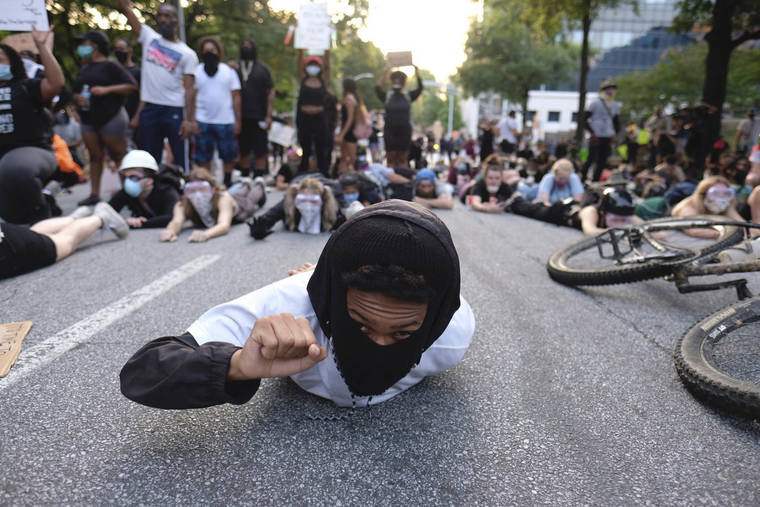8:46: A number becomes a potent symbol of police brutality

Protesters lie on a street during a demonstration Monday, June 1, 2020, in Atlanta over the death of George Floyd, who died May 25 in Minneapolis. (Ben Gray/Atlanta Journal-Constitution via AP)
MINNEAPOLIS — All protest movements have slogans. George Floyd’s has a number: 8:46
MINNEAPOLIS — All protest movements have slogans. George Floyd’s has a number: 8:46
Eight minutes, 46 seconds is the length of time prosecutors say Floyd, a 46-year-old black man, was pinned to the ground under a white Minneapolis police officer’s knee before he died last week.
ADVERTISING
In the days since, outraged protesters, politicians and mourners have seized on the detail as a quiet way to honor Floyd at a time of angry and sometimes violent clashes with police. Even as prosecutors have said little about how they arrived at the precise number, it has fast grown into a potent symbol of the suffering Floyd — and many other black men — have experienced at the hands of police.
In Boston and Tacoma, Washington, demonstrators this week lay down on streets staging “die-ins” for precisely 8 minutes, 46 seconds. Companies, including ViacomCBS and Google, used the time span in their shows of solidarity.
In Washington, Democratic senators on Thursday gathered in the U.S. Capitol’s Emancipation Hall, some standing, some kneeling on the marbled floor for the nearly nine minutes of silence.
Mourners at a memorial service for Floyd in Minneapolis on Thursday stood in silence for 8 minutes, 46 seconds, asked by the Rev. Al Sharpton to “think about what George was going through, laying there for those eight minutes, begging for his life.”
“We can’t let this go,” he said. “We can’t keep living like this.”
Pausing for a full 8 minutes, 46 seconds helps turn the abstract into a reality, said Monica Cannon-Grant, the founder of Violence in Boston Inc., which organized a Tuesday protest that included the minutes of silence.
“You find that that’s an extremely long time to have someone have their knee in the side of your neck,” Cannon-Grant said.
As she observed the silence, she said found herself thinking about the safety of her family.
“All kinds of things were going through my head,” she said. “Mainly that I was the mom of four black sons and I’m married to a black man.”
Some of the power in the number comes from its striking specificity. In a criminal complaint charging Officer Derek Chauvin in Floyd’s murder, prosecutors say they know precisely how long Floyd was pinned to the ground.
“The defendant had his knee on Mr. Floyd’s neck for 8 minutes and 46 seconds in total. Two minutes and 53 seconds of this was after Mr. Floyd was non-responsive,” the complaint concludes. “Police are trained that this type of restraint with a subject in a prone position is inherently dangerous.”
But the timestamps cited in the document’s description of the incident, much of which is caught on video, indicate a different tally. Using those, Chauvin had his knee on Floyd for 7 minutes, 46 seconds, including 1 minute, 53 seconds after Floyd appeared to stop breathing.
Prosecutors involved in the case have not responded to requests about the discrepancy.
In this case, one minute is unlikely to be major legal significance.
“Seven minutes is a long time to have a knee on someone’s neck regardless,” said Jared Fishman, a former federal civil rights prosecutor. That said, Fishman said it’s a detail defense lawyers will scrutinize in court.
For those who hold up the number as part of a peaceful call for change, the precise length of time is beside the point: “It should never have happened to begin with,” Cannon-Grant said.
It would not be the first time that a detail takes on a life of its own.
After the 2014 death of Michael Brown, word spread in the community that the black 18-year-old had his hands up in surrender when he was shot by a white police officer. The chant “Hands up. Don’t shoot!” quickly became a rallying cry for protesters both in the St. Louis suburb and across the country.
But it never was clear whether Brown actually raised his hands. There were no videos or photos of the shooting. Some witnesses swore to a grand jury that his hands were raised while others swore they were not. Officer Darren Wilson testified to grand jurors that Brown was charging at him, with one hand clenched at his side and the other under his shirt, when Wilson fired the fatal shots.
Several protesters said it didn’t matter if Brown’s hands literally were raised, because his death remained symbolic of wider racial injustices at the hands of police.


